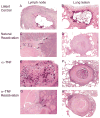Tumor necrosis factor neutralization results in disseminated disease in acute and latent Mycobacterium tuberculosis infection with normal granuloma structure in a cynomolgus macaque model
- PMID: 20112395
- PMCID: PMC3047004
- DOI: 10.1002/art.27271
Tumor necrosis factor neutralization results in disseminated disease in acute and latent Mycobacterium tuberculosis infection with normal granuloma structure in a cynomolgus macaque model
Abstract
Objective: An increased risk of tuberculosis has been documented in humans treated with tumor necrosis factor alpha (TNFalpha)-neutralizing agents. In murine models, impaired signaling by TNF causes exacerbation of both acute and chronic infection associated with aberrant granuloma formation and maintenance. This study was undertaken to investigate immune modulation in the setting of TNF neutralization in primary and latent tuberculosis in a non-human primate model.
Methods: Cynomolgus macaques 4 years of age or older were infected with Mycobacterium tuberculosis and subjected to clinical, microbiologic, immunologic, and radiographic examinations. Monkeys were classified as having active or latent disease 6-8 months after infection, based on clinical criteria. Monkeys used in acute infection studies were randomized to receive either adalimumab (prior to and during infection) or no treatment. Monkeys with latent infection that were randomized to receive TNF-neutralizing agent were given either an inhibitor of soluble TNF, recombinant methionyl human soluble TNF receptor I (p55-TNFRI), or adalimumab. Control monkeys with latent infection were given no treatment or saline. Data from previously studied monkeys with active or latent disease were also used for comparison.
Results: Administration of TNF-neutralizing agents prior to M tuberculosis infection resulted in fulminant and disseminated disease by 8 weeks after infection. Neutralization of TNF in latently infected cynomolgus macaques caused reactivation in a majority of animals as determined by gross pathologic examination and bacterial burden. A spectrum of dissemination was noted, including extrapulmonary disease. Surprisingly, monkeys that developed primary and reactivation tuberculosis after TNF neutralization had similar granuloma structure and composition to that of control monkeys with active disease. TNF neutralization was associated with increased levels of interleukin-12, decreased levels of CCL4, increased chemokine receptor expression, and reduced mycobacteria-induced interferon-gamma production in blood but not in the affected mediastinal lymph nodes. Finally, the first signs of reactivation often occurred in thoracic lymph nodes.
Conclusion: These findings have important clinical implications for determining the mechanism of TNF neutralization-related tuberculosis.
Figures





References
-
- Wallis RS. Reconsidering adjuvant immunotherapy for tuberculosis. Clin Infect Dis. 2005;41(2):201–8. - PubMed
-
- Keane J, et al. Tuberculosis associated with infliximab, a tumor necrosis factor alpha-neutralizing agent. N Engl J Med. 2001;345(15):1098–104. - PubMed
-
- Emile JF, et al. Correlation of granuloma structure with clinical outcome defines two types of idiopathic disseminated BCG infection. J Pathol. 1997;181(1):25–30. - PubMed
-
- Plessner HL, et al. Neutralization of tumor necrosis factor (TNF) by antibody but not TNF receptor fusion molecule exacerbates chronic murine tuberculosis. J Infect Dis. 2007;195(11):1643–50. - PubMed
Publication types
MeSH terms
Substances
Grants and funding
LinkOut - more resources
Full Text Sources

